外研版必修2Module4学案-必修2Module4 Grammar
外研版高中英语必修二Module 4MusicGrammar学案1
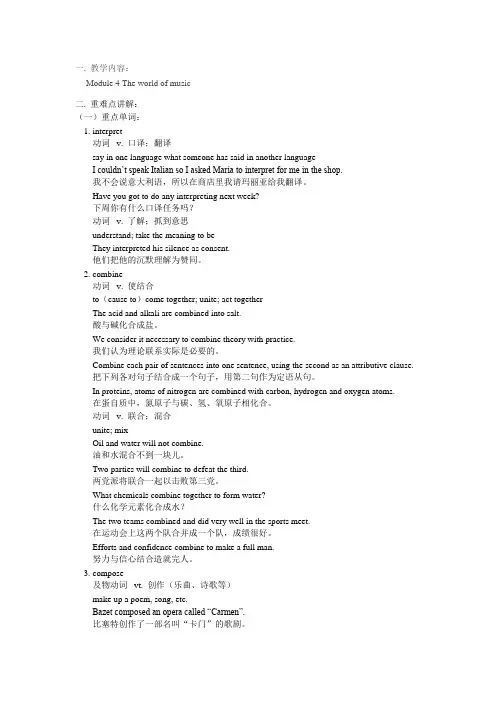
一. 教学内容:Module 4 The world of music二. 重难点讲解:(一)重点单词:1. interpret动词v. 口译;翻译say in one language what someone has said in another languageI couldn’t speak Italian so I asked Maria to interpret for me in the shop.我不会说意大利语,所以在商店里我请玛丽亚给我翻译。
Have you got to do any interpreting next week?下周你有什么口译任务吗?动词v. 了解;抓到意思understand; take the meaning to beThey interpreted his silence as consent.他们把他的沉默理解为赞同。
2. combine动词v. 使结合to(cause to)come together; unite; act togetherThe acid and alkali are combined into salt.酸与碱化合成盐。
We consider it necessary to combine theory with practice.我们认为理论联系实际是必要的。
Combine each pair of sentences into one sentence, using the second as an attributive clause.把下列各对句子结合成一个句子,用第二句作为定语从句。
In proteins, atoms of nitrogen are combined with carbon, hydrogen and oxygen atoms.在蛋自质中,氮原子与碳、氢、氧原子相化合。
动词v. 联合;混合unite; mixOil and water will not combine.油和水混合不到一块儿。
外研版高中英语必修2Module4_Grammar精讲精练课件
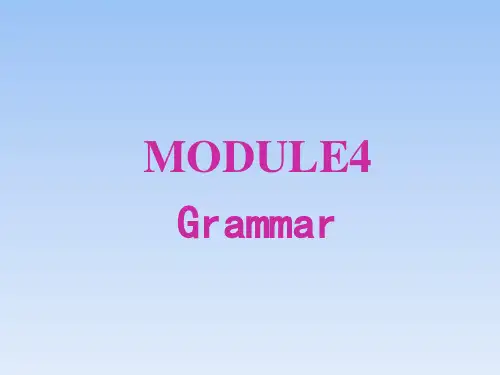
small pieces.
• A.break
B.breaking
• C.broken
D.to break
• 解析:选D。句意:“汤姆问糖果制造商们能否 把巧克力做得更易于掰成小块。”这是一个固 定句式:make sth.+adj.+(for sb.)to do“使某事 变 得 ( 使 某 人 ) 做 起 来 ……” , 如 make English easy for us to learn(使英语变得让我们学起来容 易),因此选D项动词不定式。
hospital. • 答案:staying • 5.Michael has delayed________(write) to her till
today. • 答案:writing
• 6.The law forbids________(sell) liquor to children. • 答案:selling • 7.They all suggested________(give)more chances. • 答案:giving • 8.We don’t allow________(smoke) in the office. • 答案:smoking • 9.Her work is________(look) after the children. • 答案:looking • 10.It’s no use________(sit) here waiting. • 答案:sitting
• B.to drive;driving
• C.to driving;to drive
• D.to drive;to driving
• 解析:选D。used to do表示“过去常常做某事”, get used to doing表示“习惯于做某事”。句意为: 他过去在中国都是靠右行驶,但很快他在英国习惯 了靠左行驶。
高中英语外研版必修2教案Module4(15页)
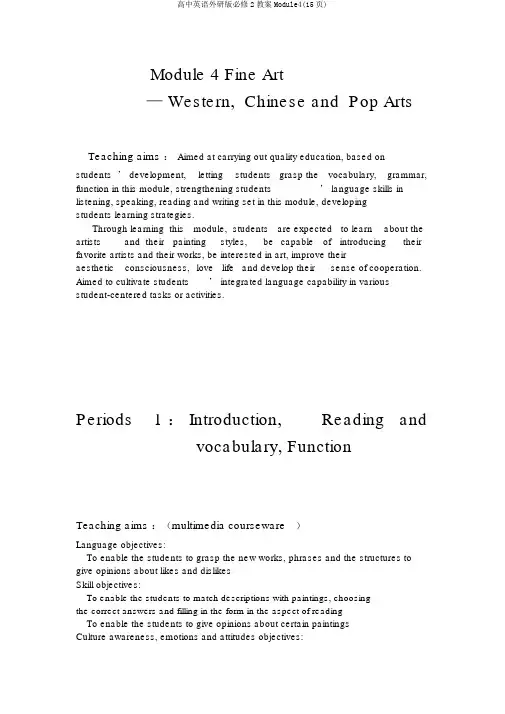
Module 4 Fine Art— Western, Chinese and Pop ArtsTeaching aims :Aimed at carrying out quality education, based onstudents’ development,letting students grasp the vocabulary,grammar, function in this module, strengthening students’ language skills in listening, speaking, reading and writing set in this module, developingstudents learning strategies.Through learning this module,students are expected to learn about the artists and their painting styles,be capable of introducing their favorite artists and their works, be interested in art, improve theiraesthetic consciousness,love life and develop their sense of cooperation. Aimed to cultivate students’ integrated language capability in various student-centered tasks or activities.Periods 1 : Introduction,Reading andvocabulary, FunctionTeaching aims :(multimedia courseware)Language objectives:To enable the students to grasp the new works, phrases and the structures to give opinions about likes and dislikesSkill objectives:To enable the students to match descriptions with paintings, choosingthe correct answers and filling in the form in the aspect of readingTo enable the students to give opinions about certain paintingsCulture awareness, emotions and attitudes objectives:Teaching important points:To enable the students to speak out opinions about some paintings with some expressionsTo enable the students to grasp the new works and phrases in thispart Teaching procedures: PWP Teaching ModelStep1. leading-in activityUseby daonnew brush, ink.the paintings The Smile of Mona Lisa Vinci and the works by Zheng Banqiao the screen to lead in the topic. Meanwhile, I will introduce the key words: artist, paint, traditional,Step 2.While —reading1)ScanningDuring the start of the period, let the students scan the passage tofind out the answers to the questions on Page32, which are about the topics.⑴M atch paintings 1-4 with descriptions in paragraphs A-D.⑵Say which paintings are mentioned in paragraph E and F.2)Detailed readingDuring this period, I’ll allow students enough time to read the textand then I let them work in groups to do the following two tasks:⑴Do the multiple choices on the screen.⑵F ill in the form on the screen, which is mainly about thefamous artists.3)Language points⑴c onsider 以为①T his is a painting by the Spanish artist, Pablo Picasso, and he isconsidered to be the greatest western artist of the twentieth century.This is a painting by the Spanish artist,Pablo Picasso,____ ____ ____ the greatest western artist of the twentieth century.②We consider that his advice is helpful.We consider his advice ____ ____ helpful.③She __________________(被以为是个可爱的孩子).⑵w ith 复合构造①C ubist artists painted objects and people, and different aspectsof the object or person showed at the same time.Cubist artists painted objects and people, ___ different aspects of the object or person ____ at the same time.②He had so much work to do, he was kept as busy as a bee.____ so much work ____ ____, he was kept as busy as a bee.③I felt a bit nervous because so many people were watching meso closely.I felt a bit nervous, ____ so many people ____ me so closely.④Because his homework had been finished, he went out to play.____ his homework ____, he went out to play.⑤He went to sleep, with the door open.He went to sleep, and ____ ____ ____ ____.⑥Tom came in, and there was a baseball bat in his hand.Tom came in, with a baseball ____ ____ ____.⑶aim 以⋯目;意欲;打算①Pop art (from the word“popular”) was an important modern art movement that attempted to show ordinary twentieth-century city life.Pop art (from the word “popular ”) was an important modern art movement that ____ ____ show ordinary twentieth-century city life.②Our aim is to start and run our own pany.We ____ ____ start and run our own pany.③I’m aiming at losing 4 kg before the summer holidays.I ____ ____ ____ lose 4 kg before the summer holidays.⑷stand 忍耐①I don ’ t like that picture of a golden-haired girl.I can ’t ____ that picture of a golden-haired girl.②We have to put up with her bad temper.We have to ____ her bad temper.③I can ’ t stand working in the extreme heat for several hours.(英)_________________________________________________⑸I got bored of looking at pictures all the time.I ____ ____ ____ looking at pictures all the time.⑹Tom gradually became interested in art.Tom ____ ____ ____ ____ art.Step3. Post—readingDuring this period, I’ ll let the students do the following tasks.⑴Find out the structures that can be used to giving opinions about likes and dislikes from the paragraphs E and F individually.⑵And then, along with the students, I’ll look through the sentences giving opinions, provided in the first part of Function, making sure that they know how to express likes and dislikes. Show the students a seriesof paintings on the screen, letting them in groups talk about the pictures they like and dislike, and why or why not, using the information learnedfrom the reading material(or in the form of interviewing—group work). Step4. HomeworkTry to find more paintings and artists you like through the Internet.Prepare to introduce a painting in English to your classmates nextclass.(The day students are assigned to the first task; and the rest ofthe students to the second.)Blackboard design:Module 4 Fine arts —Western, Chinese and Pop Arts Period Oneconsider: consider sb./sth. to be adj./n.with 复合构 : with+ +( adj./adv./prep. Phrase/-ing/-ed/inf. ) aim v./n. aim to do sth. aim at doing sth.stand+n./doing sth.get tired of/get bored of“ ⋯⋯”develop an interest in“养成⋯⋯的趣”Teaching reflection: In the process of leading in, students arefamiliar with the paintings and the artists, so the pictures can easilyarouse their interest and desire to participate.In the process of while-reading,pay attention to the developing of students reading strategies.In the process dealing with language points,setting the new words in a context helps the students learn and prehend the meaning andthe usage of them. In the discussion about their favorite paintings,some students are reluctant to speak, partly because of their lack of knowledge of painting; most students can municate with their partners or groupmembers after learning the reading materials. The task of assignment isset for the sake of the second period,that is,Listening and vocabulary, to some extent.Periods 2 : Listening and vocabulary,Everyday English, Speaking Teaching aims :To enable the students to grasp the new words in the listening material.To enable the students to prehend and put to use the everydayEnglish in the listening material.Skill objectives:To enable the students to follow the listening material about artistsand art works, which has similar difficulty to the reading material, and identify opinions.To enable the students to pay attention to the weak sound andread correctly.Teaching important points:To enable the students to follow the listening material about artistsand art works, which has similar difficulty to the reading material, and identify opinions.To enable the students to pay attention to the weak sound andread correctly.To enable the students to give opinions about certainpaintings Teaching procedures: PWP Teaching ModelStep1. Pre-listening⑴ Show some pictures on the screen;:that is, a watercolor, an oil painting, a portrait, a landscape, an art gallery.Through showing the pictures, I, together with the students study thenew words,( watercolor, oil painting, portrait,landscape, art gallery ), letting them pay attention to the pronunciation and the weak sounds/unstressed syllables of the words.⑵Then I ’ll let the students in pairs learn the meaning of the new words in the contexts, in the form of pleting the sentences with them (Part1,Page36), after reading after me.Step2. While-listening⑴B efore listening, ask the students to look at the two pictures onPage36 and find out some similarities and differences. Listen forthe first time, and answer the following questions:①What are the boy and girl are discussing?②Which picture is the boy painting, Picture1 or Picture2? Say how you know this.③Why does the girl say sorry at the end of the conversation?⑵D etailed listening/Pair workListen to the conversation again, and plete the following sentences.First let the students check their answers with their partners; thenI ’ll play the recording again for them to check; and then I ’ll check theanswers with the class.Then I’ll show the following sentences on the screen:①You’ve got it right.②Don’t change a thing.③I’m not half as good as you.④What do you make of it?⑤There’ s (an exhibition) on.⑥T hanks for the pliment.This time I ask the students to think about the meaning of the sentences after listening to the recording again, and then do the exercise on Page38 (Part1) in pairs. Then collect the answers from the whole class.Step3. Post-listening⑴L et the students describe the Picture2 on Page36 in pairs.⑵A ct the dialogue out in pairs.⑶Make up dialogues using the everyday English learned from the listening material.Step4. Homework⑴Look through the Cultural Corner and collect some works ofPablo Picasso or information about him on the Internet.⑵ Look through the Cultural Corner and tell which picture below belongsto the “ pink period ” , Which one do you like best? Which do you like least? And give your opinions about the pictures.12 3GuernicaThe day students are assigned to the first task; and the rest ofthe students to the second task.Teaching reflection:At the start of the period,using the picturesto introduce the someof the new words in the listening material can arouse students ’ interest and reduce the difficulty students have in listeningto the material.Similarly,letting students look at the two pictures on Page36 and find out some similarities and differences can arouse theircuriosity and reduce the difficulty of Question--Which picture is theboy painting,Picture1 or Picture2?Say how you know this.In the processof while-listening,After showing the six sentences taken from therecording on the screen, then let students listen to the recording while listening to the recording, which helps students prehend the everydayEnglish according to the context. In the process of post-listening, thetask of making up dialogues in pairs strengthen students’ cooperationin one aspect; meanwhile, students can grasp the usage of the everyday English. The task of assignment is set to make students learn more about art and artists and provides more chances for students to practice giving opinions. On the other hand, it is for the transition to the grammatical learning in the next period.Periods3 :Grammar1 & Grammar 2and VocabularyTeaching aims :To enable the students to grasp the usage of–ing form acting as subjects and objects and the infinitive acting as objects.To enable the students to grasp the usage of the new words and phrases. Skill objectives:To enable the students to understand the grammatical function of – ing form and the infinitive.Teaching important points:To enable the students to grasp the usage of–ing form acting as subjects and objects and the infinitive acting as objects.To enable the students to grasp the usage of the new words andphrases Teaching procedures: PWP Teaching ModelStep1. RevisionI’ ll let some volunteers show their works about of Pablo Picasso or information about him on the Internet.Step2. Leading-in/PresentingI’ ll show a series of sentences containing–ing form or the infinitive acting as subjects or objects on the students learning plan. And then let the students in groups discuss similarities and differences between thesentences and classify them according to their characteristics.Group One(verbs/verbal phrase + the infinitive as objects):1)attempt;2)promise; 9)aim; 10)pretend; 11)happen; 12)agreeGroup Two(verbs/ phrase + –ing form as objects): 4) suggest;7)stand;13)put off; 14).give up;3)be fond of; 8)get tired ofGroup Three(verbs/verbal phrase + –ing form as objects/ the infinitiveas objects): 15),16) go on; 17),18)mean; 19),20)likeGroup Four (-ing form as subjects): 5)painting; 6)copying a picture;17)being lateThen let the students continue discussing in groups and then give them a listing task, that is, adding as many verbs or phrases as they can toGroups1-3.Group One只好用不定式作的:refuse, promise, pretend, wish,hope, agree, ask, decide, expect, manage, offer,afford,agree, ask ,beg, care, choose, dare, desire, determine , fail, learn , prepare, plan, long, happen, seem⋯Group Two 只能用v-ing形式作的或短:admit,avoid, appreciate, keep, consider, delay, enjoy, escape, excuse, finish,imagine, mention, mind, miss, practice, permit, risk ,suggest,advise, allow, permit⋯feel like, give up, put off , can’t help (忍不住), can’ t stand (无法忍耐 ) , be busy in, be worth, lead to, look forward to,devote...to, stick to, be used to, get down to, object to, pay attention to⋯Group Three1) 能用不定式又能用v-ing形式,而且意差别不大的:prefer,continue, like, hate, love2)既可接不定式又可接 v-ing 形式,但含不一样的有: remember, forget,try, go on, mean, regret⋯Step3. Practice1.— You were brave enough to raise objections at the meeting .— Well , now I regret _____ that .A. to doB. to be doingC. to have doneD. doing2.The squirrel was so lucky that it just missed ____.A. catchingB. being caughtC. to be caughtD. to catch3.The teacher doesn’t permit ____ in class.A. shoutingB.shoutC.to shoutD.having shouted4.—What makes you so happy?— ____.A. Passing the driving testB.Because I ’ ve passed the driving testC. For passing the driving testD. Pass the driving test5.I forgot _____ (buy) the book, so I have to borrow one.6.Please remember____ (turn off) the light when you leave.7.Try _____ (knock) at the back door and see whether he is in or not.8.We must try ____ (e) here as early as possible.9.What do you mean ___ ( do) with it?10. I won ’t stay if it means ____(list en) to another dull talk.【速记口诀】赞同提出学会的打算,要求答应来帮忙。
外研社高中英语必修2 Module4学案gammer1语法
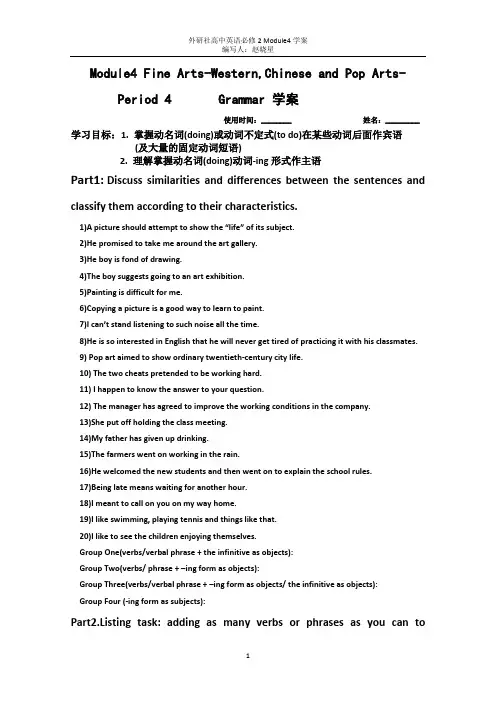
Module4 Fine Arts-Western,Chinese and Pop Arts-Period 4 Grammar 学案使用时间:________ 姓名:_________ 学习目标:1. 掌握动名词(doing)或动词不定式(to do)在某些动词后面作宾语(及大量的固定动词短语)2. 理解掌握动名词(doing)动词-ing形式作主语Part1:Discuss similarities and differences between the sentences and classify them according to their characteristics.1)A picture should attempt to show the “life” of its subject.2)He promised to take me around the art gallery.3)He boy is fond of drawing.4)The boy suggests going to an art exhibition.5)Painting is difficult for me.6)Copying a picture is a good way to learn to paint.7)I can’t stand listening to such noise all the time.8)He is so interested in English that he will never get tired of practicing it with his classmates.9) Pop art aimed to show ordinary twentieth-century city life.10) The two cheats pretended to be working hard.11) I happen to know the answer to your question.12) The manager has agreed to improve the working conditions in the company.13)She put off holding the class meeting.14)My father has given up drinking.15)The farmers went on working in the rain.16)He welcomed the new students and then went on to explain the school rules.17)Being late means waiting for another hour.18)I meant to call on you on my way home.19)I like swimming, playing tennis and things like that.20)I like to see the children enjoying themselves.Group One(verbs/verbal phrase + the infinitive as objects):Group Two(verbs/ phrase + –ing form as objects):Group Three(verbs/verbal phrase + –ing form as objects/ the infinitive as objects):Group Four (-ing form as subjects):Part2.Listing task: adding as many verbs or phrases as you can toGroups1-3. (Group work)Group One接不定式作宾语的动词:_____________________________________________________________________________ _____________________________________________________________________________ _____________________________________________________________________________ Group Two接v-ing 形式作宾语的动词或短语:_____________________________________________________________________________ _____________________________________________________________________________ _____________________________________________________________________________ Group Three:1)能用不定式又能用v-ing 形式,并且意义差异不大的动词:_____________________________________________________________________________2)既可接不定式又可接v-ing 形式,但含义不同的动词有:_____________________________________________________________________________ _____________________________________________________________________________ Part3.Multiple choice and complete the sentences with the correct forms of the words in the brackets.( Pair work)1.— You were brave enough to raise objections at the meeting .— Well , now I regret _____ that .A. to doB. to be doingC. to have doneD. doing2.The squirrel was so lucky that it just missed ____.A. catchingB. being caughtC. to be caughtD. to catch3.The teacher doesn’t permit ____ in class.A. shoutingB. shoutC. to shoutD. having shouted4. —What makes you so happy?— ____.A. Passing the driving testB. Because I’ve passed the driving testC. For passing the driving testD. Pass the driving test5.I forgot _____ (buy) the book, so I have to borrow one.6.Please remember____ (turn off) the light when you leave.7.Try _____ (knock) at the back door and see whether he is in or not.8.We must try ____ (come) here as early as possible.9.What do you mean ___ ( do) with it?10.I won’t stay if it means ____(listen) to another dull talk.11.He refused ____ (tell) me the truth of the incident.12.He has given up ____ (drink) for a long time.【高考链接】1.(2011·四川高考)Lydia doesn’t feel like _____________ abroad. Her parents are old.A. studyB. studyingC. studiedD. to study2.(2010·上海高考)I had great difficulty ___________________ the suitable food on the menu in that restaurant.A. findB. foundC. to findD. finding3. 【2009陕西,12】I still remember ____________ to the Famen Temple and what I saw there.A. to takeB. to be takenC. takingD. being taken4. 【2011上海,27】It’s no use __________________ without taking action.A. complainB. complainingC. being complainedD. to be complained5. — I feel like ___________________ for a walk. Will you go with me?— If Mary goes, _______________________.A. to go;I alsoB. to go;so do IC. going;so will ID. going;so do I6. 【2009上海,35】Bill suggested ______________ a meeting on what to do for the Shanghai Expo during the vacation.A. having heldB. to holdC. holdingD. holdPart4.Reciting the pithy formulas.接不定式作宾语的动词【速记口诀】同意提出学会的打算,要求答应来帮忙。
高中英语必修二(外研版)学案:Book2 Module4 Grammar

高中英语必修二(外研版)学案:Book2 Module4 Grammar
一、教学目标解读
1. 识记常用动词及短语。
2.掌握动名词作主语的用法并实际运用到考试题型中。
二、预习任务安排
在考试写作文和短文改错的时候,很多同学在动名词这个问题上容易犯汉式英语的错误。
如;1,上大学是每个人的梦想。
Go to college is every one’s dream. (×) Every one’s dream is to go to /going to college. (√)
2,把英语学好并不困难。
Learn English well is not difficult.(×)
Learning English well is not difficult.(√)
It is not difficult to learn English well.(√)
五、知识点睛:
我们熟悉的动名词除了做主语和宾语以外,动名词作状语也是一个常考的考点。
Having worked there for 30 years, Heydon moved to London.(动名词的完成式, 表示
的时间状语)
Having been to the Great Walls for many times, I didn’t go with them yeaterday.(动名词的完成式, 表示的原因状语)。
外研版高中英语必修2 Module4 词汇导学案
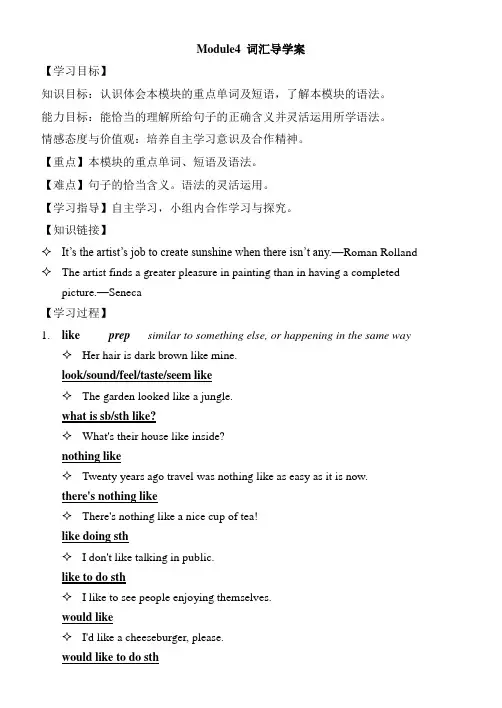
Module4 词汇导学案【学习目标】知识目标:认识体会本模块的重点单词及短语,了解本模块的语法。
能力目标:能恰当的理解所给句子的正确含义并灵活运用所学语法。
情感态度与价值观:培养自主学习意识及合作精神。
【重点】本模块的重点单词、短语及语法。
【难点】句子的恰当含义。
语法的灵活运用。
【学习指导】自主学习,小组内合作学习与探究。
【知识链接】✧It’s the artist’s job to create sunshine when there isn’t any.—Roman Rolland ✧The artist finds a greater pleasure in painting than in having a completedpicture.—Seneca【学习过程】1.like prep similar to something else, or happening in the same way✧ Her hair is dark brown like mine.look/sound/feel/taste/seem like✧The garden looked like a jungle.what is sb/sth like?✧What's their house like inside?nothing like✧Twenty years ago travel was nothing like as easy as it is now.there's nothing like✧There's nothing like a nice cup of tea!like doing sth✧I don't like talking in public.like to do sth✧I like to see people enjoying themselves.would like✧I'd like a cheeseburger, please.would like to do sth✧I'd like to see that film.whatever/wherever/anything etc you like✧You can sit wherever you like.as long as you like/as much as you like etc✧You know you're welcome to stay with us as long as you like.✧Take as many as you like.nsb's likes and dislikes✧We all have our own likes and dislikes when it comes to food.2.colourful adj having bright colours or a lot of different colours✧ a colourful display of flowersinteresting, exciting, and full of varietycolourful history/past/career/life✧Charlie Chaplin had a long and colorful career.colourful character/figure(=someone who is interesting and unusual)3.delightful adj very pleasant✧ a delightful little girldelighted adj very pleased and happydelighted to do sth✧Sandy will be delighted to see you.delighted (that)✧I'm delighted that we have settled the matter.delighted with/by/at✧She was delighted with her new home.4.traditional adj being part of the traditions of a country or group of people✧ a traditional method of brewing beerit is traditional (for sb) to do sth✧It is traditional not to eat meat on Good Friday.5.aspect n [C] one part of a situation, idea, plan etc that has many partsaspect of✧Dealing with people is the most important aspect of my work.。
外研版高中英语必修2Module4_Grammar_名师课件
难点突破:
1.John was made A the car for a week
as a punishment A. to wash B. washing C. wash
2. I heard her B at 8:00 yesterday.
A. sing B. singing C. sang
3. You mustn’t let him A too much TV.
hear, feel
如:老板让工人们整天都工作。 The boss made the workers_w__o_r_k_
all day.
但这些词在被动语态里要还原to 如:昨天我看见他踢球。
I saw him play football yesterday.
He was seen __to__p_l_a_y__football
难点突破1:
常考:in order to / too … to
1 She ran fast
in_o_r_d_e_r__to__c_a_t_c_h___(为了赶上)
the first bus. 2、I was_to_o__t_ir_e_d_t_o__fa_l_l _a_s_le_e_p____ (太累了,难于入睡。)
注意1:
有些词既可接动词不定式又可 接动名词,但含义不同,你 认识它们吗?
含义不同:
remember to do sth.记得要做某事 remember doing sth.记得做过某事 forget to do sth.忘记要做某事 forget doing sth.忘记曾经做过某事 stop to do sth. 停下来去做某事 stop doing sth.停止做某事 mean to do sth 打算做某事 mean doing sth意味着做某事 regret to do sth.很遗憾要做某事 regret doing sth. 后悔做了某事 try to do sth.尽力去做某事 try doing sth.尝试去做某事
外研版英语教材必修2同步学案Module 4
高一同步学案必修2 Module 4Fine Arts--- Western, Chinese and Pop Arts知识详解① observe vt .& vi.观察,注意到;遵守(法律、习俗等);庆祝(节日等);评论,评述(回归课本P33)Qi Baishi observed the world of nature very carefully,and his paintings are special because of this.齐白石对自然界观察得很仔细,他的画因此而别具特色。
【归纳总结】①He observed that the key was missing the moment he got home.他一到家就发现钥匙不见了。
②Ben knew that someone had observed him meeting Ryan.本知道有人看到他和瑞安见面了。
③Does everyone observe the speed limit in your country?在你们国家是否人人都遵守限制车速的规定?④She observed that the journey was long and tiring.她说这次旅行又长又累。
【例句探源】1.Though having lived abroad for years,many Chinese still ________ the traditional customs. A.perform B.possessC.observe D.support解析:选C。
observe在此句中意为“遵守”。
perform履行,执行,表演;possess占有,拥有,摆布,支配;support支持,支援。
2.完成句子Every one is expected to______________________.人人应该遵守交通规则。
答案:observe the traffic rules【即境活用】② adopt vt.采纳,采用;收养(回归课本P32)a style of painting adopted by a group of artists一种被一群艺术家所采用的绘画风格【归纳总结】①Having no children of their own, they decided to adopt an orphan.因为他们没有亲生儿女,所以决定领养一个孤儿。
学案(外研版必修2)module4.doc
Module 4 Fine Arts- Western, Chinese and Pop Arts 学案i.重点单词1.paint vt. vi.粉刷;刷漆;(用颜料)绘画We painted our house white.n. [c] [u]油漆;绘画颜料painter画家;油漆工painting n. [u]绘画,画法[c]画,油画,水彩画2.alive adj.(表语和补足语)活着的;有活力的;充满......的(常与with连用)catch sb/sth.. alive 活捉...living adj俵语和定语)活着的lively adj.活泼的;生动的;栩栩如生;强烈的live adj.活的,生动的,精力充沛的,实况转播的adv实况转播地3.observe vt. vi.观察;注意到;庆祝;遵守;陈述(意见)The police observed the man entering / enter the bank.When driving, you must observe the speed limit.Chinese all over the world observe the Spring Festival.observer n,观察者observation n,观察,注意observatory n.天文台;气象台;观察台4.adopt vt.采纳;采用;过继,收养They adopted my suggestion. The poor child was adopted by the couple.5.aim⑴vi.vt.以......为目标;打算;意欲;瞄准aim at (doing) sth aim to do sthaim sth at sth用某物瞄准某物(2). n. [c]目的,目标[u.]瞄准aimless adj.无目标的aimlessly adv.无目标地aimlessness n. [u]无目的6 realize vt.认识到;了解;实现realization n. [u]领悟,认知,理解7.destroy vt.破坏;毁坏;粉碎destruction n. [u]破坏;毁灭destructive adj.破坏的;毁灭性的8.consider(1). vt. vi.仔细考虑,思考其后接动词时,需用动词的ing形式。
高一英语外研版 必修2 module 4 语法导学学案
如无do,则接___________________.
1). In that case I could do nothing but______(stay) at home.
2) I had nothing to do but_______(agree) with him.
2)_______________________________________________________
翻译并背诵句型:
It is no good/use (fun, a pleasure, a waste oftime) doing...
There is no use /good doing...
----------------------------------------------------------------------
--------------------------------------------------------------------
--------------------------------------------------------------------
3.写出只接不定式to do作宾语的动词和汉语意思。
----------------------------------------------------------------------
----------------------------------------------------------------------
温馨小提示:
4. How to use -ing form and infinitive.
- 1、下载文档前请自行甄别文档内容的完整性,平台不提供额外的编辑、内容补充、找答案等附加服务。
- 2、"仅部分预览"的文档,不可在线预览部分如存在完整性等问题,可反馈申请退款(可完整预览的文档不适用该条件!)。
- 3、如文档侵犯您的权益,请联系客服反馈,我们会尽快为您处理(人工客服工作时间:9:00-18:30)。
高一必修二第4模块语法学案
学习目标:掌握动词不定式和动名词的用法。
学习重点:动词不定式和动名词在题中的应用。
学法指导:记忆,练习。
学习难点:会运用动词不定式和动名词
探究过程:
动词不定式和动名词句法功能比较一览表
1. 动名词与不定式作主语
(1)表示一般抽象概念均可。
Reading/ To read good books enriches our mind.
(2).表具体的特定情况或有待于完成的动作,常用不定式。
Swimming is good for health, but to swim in such a polluted river is harmful to health.
(3)在it作形式主语的句中,若表语是necessary, important等形容词时,后面只用不定式,若表语是no use, no good, a waste of time 时,常用动名词。
①It is necessary___________( spend) enough time on
English if you want to learn it well.
②It is no use at all ___________(argue) with him about it.
(4)在there is no后只加动名词面。
不知道他来不来
There is no knowing whether he will come here or not.
2.动名词与不定式作表语
(1)通常可以互用。
His habit is having/to have a walk after supper.
(2).指具体的、特定情况下或未发生的动作,常用不定式。
Your work today is to carry these things upstairs.
(3).主语的形式要和表语保持一致。
To see is to believe.
Seeing is believing.
3.后面只跟ing 形式作宾语的动词:
admit, allow, avoid, delay, dislike, miss, finish, advise, mind, consider, practise, suggest, keep, excuse, enjoy, permit, escape
He tried to avoid ___________(answer) my question.
Would you mind ___________(close) the door?
She suggested ________(go) to the cinema.
4.后面常跟ing形式作宾语的动词词组:
give up, put off, carry on, keep on, feel like, get used to, insist on, look forward to, succeed in, think of, dream of, can’t help, be worth David has given up ___________(smoke).
Do you feel like ____________(go) out tonight?
I’m looking forward to __________(meet) her.
The picture isn’t worth ____________(look) at.
5.只能跟不定式作宾语的动词
promise, demand, ask, aim, pretend, wish, hope, expect, manage, can afford, offer, agree, learn, prepare, claim, dare, decide, determine, refuse等。
①He failed_______( pass) the driving test.
②He offered __________( take) the child home.
③I can’t afford __________( buy) a car.
6.有些词后跟不定式或动名词意义不同:
remember, forget; try; mean; stop, go on; regret; want, need, require regret doing sth 对已经发生的事感到遗憾。
regret to do 对将要说的事感到遗憾。
I regret telling/ having told her what I thought.
译:___________________________________________
I regret to tell you that you failed in the exam
译:___________________________________________________ wainnt dog/ want to be done 需要被做
The classroom really wants/needs/ requires cleaning.
译:_________________________________________
My car needs repairing/to be repaired.
译:_____________________________________________
课堂检测:用斜题字单词完成下列句子
draw, practise, spend, step, listen, send, have, control, move, work, help
1.He is so interested in English that he will never get tired of
_________ speaking it with his classmates.
2. The astronaut hopes ______ out of his space- ship and walk in space.
3. At the end of the term, all the students look forward to
_______ some holiday.
4. Would you plea se turn down the radio? I can’t stand
________ to such noise all the time.
draw, practise, spend, step, listen, send,
have, control, move, work, help
5.China has succeeded in _______ up many satellites into space.
6. The boy attempted ________ the boat all by himself, but failed.
7. The man went on ________ until late night every day because he had to complete the task in time.
8. Once I have promised ______ you, I will try my best.
9. The artist likes _______ in ink.。
